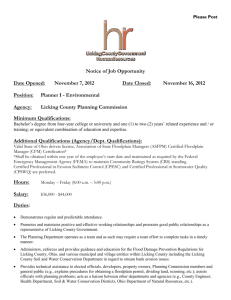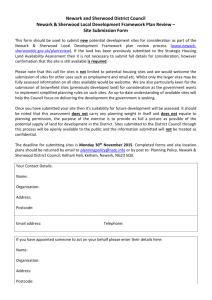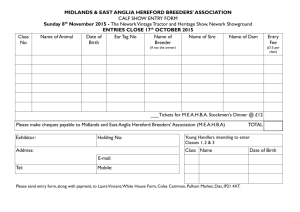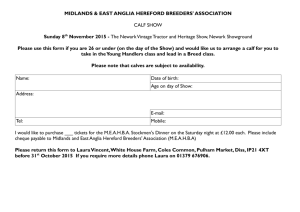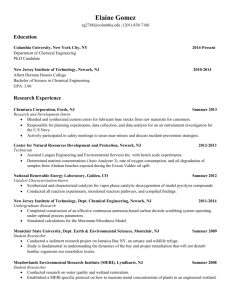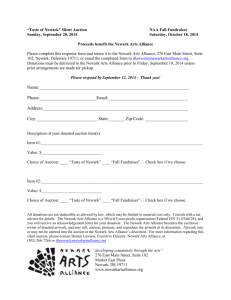HISTORY OF LICKING COUNTY - Licking County Historical Society
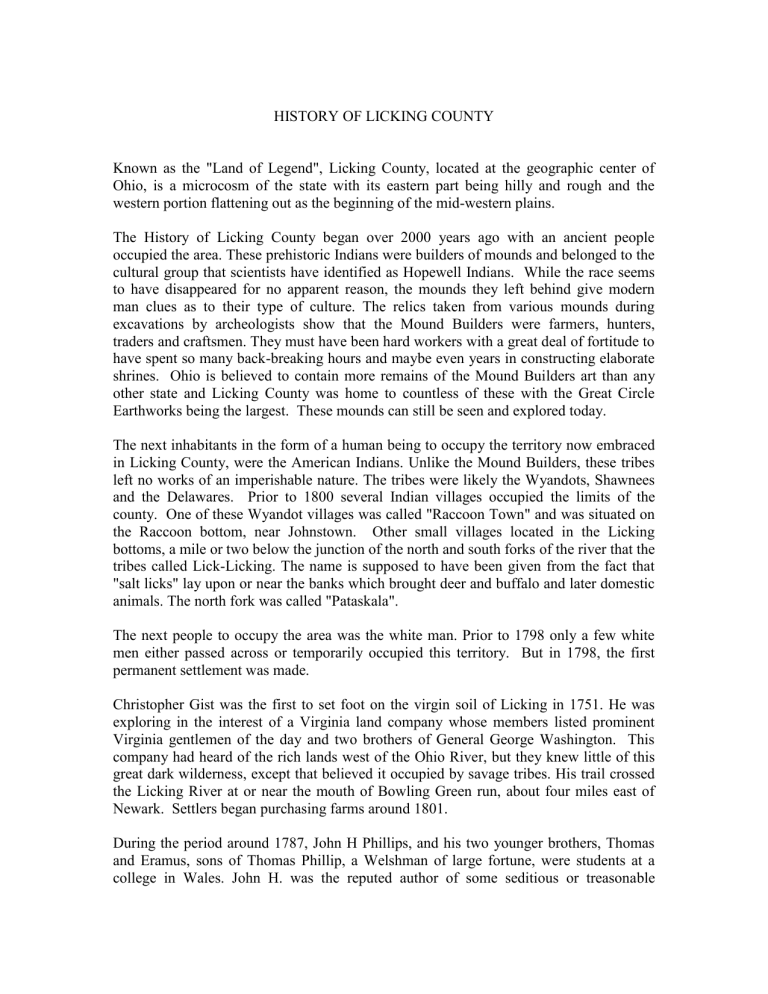
HISTORY OF LICKING COUNTY
Known as the "Land of Legend", Licking County, located at the geographic center of
Ohio, is a microcosm of the state with its eastern part being hilly and rough and the western portion flattening out as the beginning of the mid-western plains.
The History of Licking County began over 2000 years ago with an ancient people occupied the area. These prehistoric Indians were builders of mounds and belonged to the cultural group that scientists have identified as Hopewell Indians. While the race seems to have disappeared for no apparent reason, the mounds they left behind give modern man clues as to their type of culture. The relics taken from various mounds during excavations by archeologists show that the Mound Builders were farmers, hunters, traders and craftsmen. They must have been hard workers with a great deal of fortitude to have spent so many back-breaking hours and maybe even years in constructing elaborate shrines. Ohio is believed to contain more remains of the Mound Builders art than any other state and Licking County was home to countless of these with the Great Circle
Earthworks being the largest. These mounds can still be seen and explored today.
The next inhabitants in the form of a human being to occupy the territory now embraced in Licking County, were the American Indians. Unlike the Mound Builders, these tribes left no works of an imperishable nature. The tribes were likely the Wyandots, Shawnees and the Delawares. Prior to 1800 several Indian villages occupied the limits of the county. One of these Wyandot villages was called "Raccoon Town" and was situated on the Raccoon bottom, near Johnstown. Other small villages located in the Licking bottoms, a mile or two below the junction of the north and south forks of the river that the tribes called Lick-Licking. The name is supposed to have been given from the fact that
"salt licks" lay upon or near the banks which brought deer and buffalo and later domestic animals. The north fork was called "Pataskala".
The next people to occupy the area was the white man. Prior to 1798 only a few white men either passed across or temporarily occupied this territory. But in 1798, the first permanent settlement was made.
Christopher Gist was the first to set foot on the virgin soil of Licking in 1751. He was exploring in the interest of a Virginia land company whose members listed prominent
Virginia gentlemen of the day and two brothers of General George Washington. This company had heard of the rich lands west of the Ohio River, but they knew little of this great dark wilderness, except that believed it occupied by savage tribes. His trail crossed the Licking River at or near the mouth of Bowling Green run, about four miles east of
Newark. Settlers began purchasing farms around 1801.
During the period around 1787, John H Phillips, and his two younger brothers, Thomas and Eramus, sons of Thomas Phillip, a Welshman of large fortune, were students at a college in Wales. John H. was the reputed author of some seditious or treasonable
literature, and to avoid arrest and punishment, decided to emigrate to America. Many of their old Welsh neighbors, by arrangement, through the kind generosity of Thomas
Phillips, and a Theophilus Rees, and neighbor and friend, came as emigrates in the same ship. In 1801, Thomas Phillips and Theophilus Rees purchased two thousand acres of land situated in what is now the northeast quarter of Granville township.
Early in 1802, William Schenck, G. W. Bernet and John Cummins came from a settlement in New Jersey to inspect a section of Military Land they had purchased for about two dollars an acre. After looking their land over, these men decided that the junction of the forks of the Licking River, would be a good spot for a town. After surveying the area and platting the town, they decided to call it "New Ark" after
Schencks native town in New Jersey. The plat was drawn and recorded at Lancaster, the county seat of Fairfield County which at that time included Newark. However, shortly after the original plat was drawn, an addition of alteration was made and the town name was spelled as one word. The town began with two hewed log houses on what is now known as the public square. By 1808, a log building was built on the site of the present public square. This building served not only as the first court house, but was also used as a non-denominational church. From these humble beginnings, the village continued to grow in population and prestige, until the year of 1833 when it was incorporated as a village under the laws of the state of Ohio.
By the 1820s, the pioneers were living life a little easier. Their farms were partially cleared, many of them were living in hewed log houses and many in frame and even brick homes. Most had barns and innumerable out-houses. Living in comparative comfort, they generally had cattle, horses, sheep, hogs and poultry. They had businesses, schools and churches. The county was full of produce for which there was no market.
Ham was worth three cents per pound; eggs, four cents per dozen; flour, one dollar per hundred; whiskey, twelve and half cents per gallon, and other things proportionately cheap.
A large majority of the people of Ohio knew little about the Ohio canal, and the interest taken in it at the commencement of the work. This was considered one of the greatest undertakings of the age. To carry on the work by the commissioners appointed by the legislature, Judge D. S. Bates, an experienced engineer of the state of New York, and in their wisdom, made "Licking Summit" in this county, the place of beginning. They then gave notice to all concerned throughout Ohio and the adjoining states, that a commencement of the excavation would be made on the fourth of July, 1925. The invited guests included many of the notables of the state and nation. Among them were Governor
De Witt Clinton, of New York; then Governor Morrow; and ex-Governor Worthington.
This construction of the canal began a new era in Licking County. Businesses sprang up, and the town of Newark grew to bustling place. The area became a beehive of activity with farmers bringing produce and meat to market for shipping to other parts of Ohio and points east. On Saturdays many boatmen assembled, mixing with farmers and towns people on Ginger Bread Row and on the canal front. The Ohio Canal was finished in
1833, at a cost of $14,688.667. But the canal did all that was prophesied, and possibly
more. Farmers, their sons and teams, got work for wages in the slack seasons; a man earned 30 cents a day, sun-up to sun-down, with food, shanty and whiskey. The brawling crew of laborers, fought and drank and filled the jails on Saturday nights. But they dug the ditches, and a stream of wealth flowed into Licking County on the canal. As the railroads came and took on more importance and more miles of track was laid, the canal gradually began to loose its value. The canal system reached its peak about 1851, and then very rapidly declined. Boats no longer operated in that part of the canal passing through Newark after the 1890's. In 1908 the great Ohio Canal was filled in.
Agricultural has always been important to Licking County since the first Licking County
Agricultural Society was formed in 1832. The society held a fair every year on some outlots or on lands adjacent to Newark. On September 19, 1854, the Ohio State fair was scheduled to open at the large Circle Mound in Newark, by then known as the "Old Fort".
But due to the last cholera epidemic to hit Newark, the fair didn't open until October 17 th
.
The fairgrounds thrived because of easy access of the railroad. By then the Interurban ran through town with a direct line to and from the fairgrounds where there was a hotel and theatre, as well as five lakes and other attractions.
In the latter part of October 1861, in order to try to induce enlistment in the Civil War, the Old Fort was selected as a rendezvous place for the 76 th
Regiment of Ohio Volunteers and renamed Camp Sherman. The local West Pointer, Col Charles R. Woods was put in command. By the end of November the 700 or so enlistees in the camp were visited by their families, weighted down with food and presents from town, could visit the men periodically. According to some the "whole aspect of the camp was of a novelty carnival atmosphere and resembled something of a lark"." But all of this came to an end when the boys had to break camp on February 9, 1862, and finding themselves on the battle front at
Fort Donelson. Many Licking County men and women answered the call of their country during the early conflicts of America and later during the Civil War, World Wars I and II,
Korea, Vietnam and the Gulf War. To honor the memories of these veterans, on
November 1996, the city dedicated "The Veterans Walk of Honor" in Veterans Park.
The Fairgrounds were such a beautiful place and used only once a year for fairs, that in
1898, a banker, J. F. Linginfelter, established a summertime entertainment resort. But the resort lasted only a few years after the Buckeye Lake part was established in 1902. By
1910 the park was flourishing and became the playground of Ohio. They came by the tens of thousands and they danced thousands of nights away. From the 1930s, 40, and even into the early 1970s, Buckeye Lake was a forerunner of the massive parks such as
King's Island and Cedar point of today. Who can guess how many romances began as couples danced to the lilting strains of Guy Lombardo and his Royal Canadians, the
Tommy and Jimmy Dorsey Orchestras, Stan Kenton, Ray Anthony, Benny Goodman or
Louis Armstrong. By 1972, when the park closed, these names had become only memories of a by-gone era.
Over the past two hundred years, Licking County has held up to the name "Land of
Legend". People and events have kept this alive. Famous people coming from and contributing to the legends include:
Johnny Appleseed who scattered the countryside with seeds of apples and wild herbs such as dog-fennel, pennyroyal, may apple, horehound, catnip, and winter green. A few old twisted apple trees that he planted over a hundred years ago still remain in the Welsh Hills.
Victoria Clafin Woodhull was a feminist pioneer who rose up from poverty to become the first woman Wall Street broker, the first woman to testify before
Congress (on suffrage), and in 1872, the first woman to run for president.
Edward James Roye, a black man born in Newark, was elected president of the republic of Liberia in Africa, in 1870.
Julia Dent Grant, the daughter of a Newark store owner, became the bride of
Ulysses S Grant in 1848. She became a very gracious hostess of the 18 th president of the United States.
Newark's most famous son, John Joseph Clem became a Civil War hero at the age of 10 serving as drummer boy at the battle of Shiloh where he earned the nickname of "Johnny Shiloh". Johnny Clem retired as a Major General in 1917.
Thomas D Jones, sculptor, followed his father's trade as a stone cutter in Granville in the early 1800's. President Abraham Lincoln chose him as the only sculptor for whom he ever sat. The bust in white Carrara marble sits in the State House in
Columbus.
Warren Weiant, prominent owner of extensive greenhouses around 1905, growing trees, roses, vegetables lettuces and tomatoes.
A.
H. Heisey and Company carried more prestige than any other company in
Newark history. Manufacturers of Glassware, their items have become collectibles around the world.
Alexander Samuelson, original design, patented in 1915, became the "most famous bottle in the world" - the Coco-Cola Company' s adopted bottle design.
Licking County was the center of the window glass industry between 1903 and
1929.
The Wehrle Company, home of the world's largest stove manufacturing.
John and Harry Swisher Brothers made their homes and factory in Newark.
Manufacturing cigars. Their factory became one of the worlds largest with their
nearly eighty nine different sizes and shapes of cigars. These included the King
Edward. The company became such a success the small factory at Newark became insufficient and the next desirable location was in Chillicothe.
In June of 1929, Beman Gates Dawes, his wife Bertie Burr Dawes and brother
Charles Gates Dawes founded the Dawes Arboretum. Berman and Charles family included ancestors who rode with Paul Revere, pioneers in botanical and horticultural sciences and civil war heroes. Charles was Vice-President o Calvin
Coolidge, a Nobel Prize winner and appointed American Ambassador to the Court of Saint James. Berman himself was an engineer/bridge builder, two-term
Congressman from the 15 th
district, president and founder of the Pure Oil
Company, farmer, fisherman, gardener and horticulturist. Bertie was a Gold
Medal of Honor recipient, accomplished tennis player, photographer, naturalist, botanist, ornithologist and horticulturist. Thousand of visitors each year enjoy the serenity and awesome beauty of the 1,149 acres at the Arboretum.
Marcus A. Root living in Granville in 1830, was determined to become an artist.
After following his first career in art, he established a penmanship school in
Philadelphia. Learning of a photographic development by a Frenchman, Louis
Jacques Mande Daguerre, call the Daguerreotype, Root opened a new direction and fulfillment of his ambitions. He now could reproduce portraits with a camera and gain his fortune. He opened studios in Philadelphia, New York, Mobile,
Alabama, New Orleans, St Louis, Boston and Washington. He was awarded first prize at the World's Fair in London in 1851. In the Centennial of 1876, he exhibited a collection of pictures of the most famous people in America taken by the daguerreotype process. His works of Henry Clay and Daniel Webster were used for portraits on US currency.
Licking County continues to become the "Land of Legend" with the findings of prehistoric beasts in Johnstown and the area of a Newark golf course. It continues to grow and prosper with businesses manufacturing golf clubs, the making of Velvet Ice Cream, and Aero Space Guidance System Repair work.


